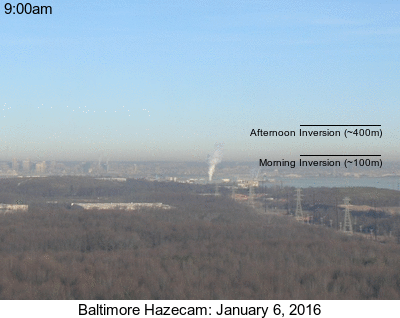New, more protective ozone standard
Last fall, the U.S. Environmental Protection Agency strengthened the health-based air quality standard for ozone, lowering the standard from 75 parts per billion (ppb) to 70 ppb. The updated standard will improve public health protection, particularly for at-risk groups such as children, older adults, people with heart or lung diseases and outdoor workers. Because of the new, more stringent yardstick being applied to ozone levels, the number of poor air days that are forecast and observed is expected to increase by about 30 percent. This doesn’t mean air quality has suddenly gotten worse. It means a more protective standard is now in place.
What's an inversion and why should I care?
 Have you heard the term “inversion” but not really understood what it means? An inversion is simply when temperature increases with increasing height. Normally temperature decreases with increasing height. This decrease in temperature is what allows snow on mountain tops while it may be sweltering at the mountain base. Inversions themselves are invisible – we can’t see the air. However, we can see what affect inversions have on the atmosphere. That’s becauseinversions act as a lid and trap whatever is emitted between them and the ground. This is particularly evident with pollution and most apparent during the winter months when inversions are typically the strongest. In the animated image to the left, a strong morning inversion developed over Maryland on Wednesday, January 6, 2016. Downtown Baltimore can be seen in the center left of the image. The image spans from 9am to 5pm local time. Without sunlight, inversions strengthen. As the sun had only risen briefly by 9am, the inversion on January 6th was near its lowest height (strongest intensity) of the day as often occurs near sunrise. Trapped pollution is evident as a “brownish” color due to elevated concentrations of nitrogen dioxide very near to the ground which is emitted from cars and other combustion sources. At the beginning of the animation, the brown area is very near the ground (lower black line) while up above a very blue, clean sky is visible, evidence of clean air. Over the course of the next few hours, the inversion “lifts”, that is, the pollution of the city (the brownish area) rises to a higher height (upper black line noted on the image). This increase in height of the inversion decreases pollution concentrations near the surface and is why in winter time, the most polluted part of the day is often in the early morning hours.
Have you heard the term “inversion” but not really understood what it means? An inversion is simply when temperature increases with increasing height. Normally temperature decreases with increasing height. This decrease in temperature is what allows snow on mountain tops while it may be sweltering at the mountain base. Inversions themselves are invisible – we can’t see the air. However, we can see what affect inversions have on the atmosphere. That’s becauseinversions act as a lid and trap whatever is emitted between them and the ground. This is particularly evident with pollution and most apparent during the winter months when inversions are typically the strongest. In the animated image to the left, a strong morning inversion developed over Maryland on Wednesday, January 6, 2016. Downtown Baltimore can be seen in the center left of the image. The image spans from 9am to 5pm local time. Without sunlight, inversions strengthen. As the sun had only risen briefly by 9am, the inversion on January 6th was near its lowest height (strongest intensity) of the day as often occurs near sunrise. Trapped pollution is evident as a “brownish” color due to elevated concentrations of nitrogen dioxide very near to the ground which is emitted from cars and other combustion sources. At the beginning of the animation, the brown area is very near the ground (lower black line) while up above a very blue, clean sky is visible, evidence of clean air. Over the course of the next few hours, the inversion “lifts”, that is, the pollution of the city (the brownish area) rises to a higher height (upper black line noted on the image). This increase in height of the inversion decreases pollution concentrations near the surface and is why in winter time, the most polluted part of the day is often in the early morning hours.
*The white plume seen in the center of the image is steam. It illustrates changing wind direction during the day due to heating differences between the water and land.
